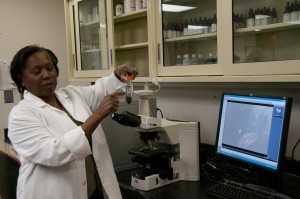Microbes do the work to purify Cook County area’s water
By Kevin Beese for Chronicle Media — February 11, 2016
Toni Gymph-Martin, microbiologist for the Water Reclamation District, holds a water test sample. (Photo courtesy of Metropolitan Water Reclamation District)
The second in a three-part series examining how the Metropolitan Water Reclamation District of Greater Chicago’s Stickney plant – the largest wastewater treatment plant in the world – affects residents.
Continually checking wastewater samples through microscopes and other microbiological analyses,, Toni Glymph-Martin and other microbiologists at the Metropolitan Water Reclamation District of Greater Chicago’s Stickney plant help to ensure that the 1.5 billion gallons of water flowing through the MWRD system each day are treated properly.
Not only do they closely monitor the delicate balance needed at the largest wastewater treatment plant in the world, but they also monitor water at the other six MWRD treatment plants as well.
“We test the effluent (liquid) and the solids (biosolids) in the wastewater,” Glymph-Martin said. “We test for bacteria, viruses and parasites.”
It is not a case of ensuring the right mix of chemicals is correctly purifying the area’s wastewater. Microbiology staff is making sure the right mix of bacteria and other microbes are getting the job done. If there are not enough microorganism present to do the job, adjustments can be made to the process to assure the proper numbers and types of microorganisms are present to do the job.
“We monitor the water when it is coming in and going out of the plant,” Glymph-Martin said.
Glymph-Martin doesn’t get too technical with scientific explanations when speaking with laymen about how microscopic creatures clean Chicago area’s wastewater. She describes the microorganisms in easy-to-understand terms.
“This one is like my son,” Glymph-Martin said while pulling up a video of a microorganism from her desktop computer. “He stands in one place and sucks the food (mostly bacteria in the wastewater) into his head. !”
“It really is a balancing act,” Glymph-Martin said of treating the region’s wastewater..
Glymph-Martin said staff examine water samples and provide assistance as neededbased on the number and types of microorganisms present..
Glymph-Martin noted that scientists’ in the Analytical Microbiology Section monitor different stages of the treatment process.
Twelve microbiologists and technicians work in the lab, helping to monitor the wastewater treatment process. The staff includes four microbiologists and nine technicians who conduct research and monitor bacteria, viruses and parasites at MWRD
“Microogranisms are involved in the whole process of wastewater treatment,” Glymph-Martin said.
Next week: Becoming a blooming business
Related content: Treating area’s waste a massive undertaking
— Microbes do the work to purify area’s water —



